Message Format – HTML, Plaint Text, and Rich Text
Have you ever received messages with regular text only, or emails with plenty of images and various font formats, such as bold, Italic, underline, color, etc. in Outlook? Outlook supports to send emails in different message formats: HTML, Plain Text, and Rich Text. And in this tutorial, I will talk about the message formats and how to apply them to messages in Outlook.
Table of Content
- 1. Available types of message formats
- 2. Change message format to HTML, Rich Text Format, or plain text
- 3. Change default message format for all new messages
- 4. Change message format of a received email
- 5. Always reply or forward in plain text
- 6. Always reply or forward in HTML format
- 7. Always reply or forward in HTML, Plain Text, or Rich Text format In Outlook
Note: Methods introduced on this page apply to Microsoft Outlook 2019 desktop program in Windows 10. And the instructions may vary significantly or slightly depending on the version of Microsoft Outlook and the Windows environments.
1. Available types of message formats
Microsoft Outlook offers three kinds of message formats: HTML, Rich Text, and Plain Text. Each message format meets different needs.
1.1 HTML
The HTML format is the most popular type of message format in Outlook.
As we know, HTML is a web page language, which help us to code our web page with rich formatting text, pictures, and other objects. Similarly, the HTML format makes the whole message content look like a nice and neat web page. The emails in HTML format support most of common font formatting, paragraph formatting, alignments, etc. what is more, emails in HTML format can be recognized by most of email clients.
Outlook users can directly apply a message theme to create a HTML message with multiple preset headings, font formatting, alignments, etc. On the other hand, Outlook users also can decorate a HTML email by bold font, italic text, underline, highlight color, advanced text effects, etc. as they need.
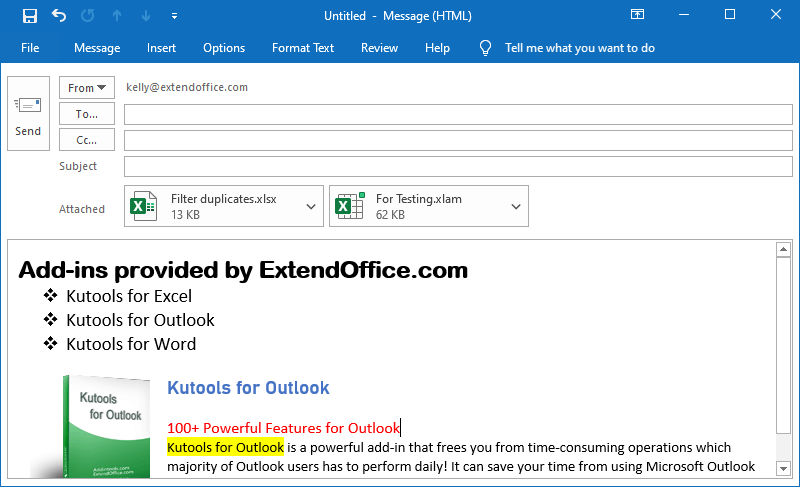
However, you must have noticed that some pictures and shapes cannot display in recipients’ Outlook directly, and require recipients to download them manually. What’s worse, Outlook recipients can configure to prevent from downloading any pictures in HTML emails. If pictures are not downloaded and displayed in the recipients’ Outlook, these pictures will be replaced with picture placeholders, which will make the whole message messy.
1.2 Plain Text
Compared with HTML format, the Plain Text format only supports regular text in the message body. The Plain Text format does not support any formatting, such as bold, italic, underline, strikethrough, highlight colors, etc. It also does not support showing pictures and hyperlinks inside the message. If you need to insert important pictures in the message, the only valid solution is to attach them as attachments.
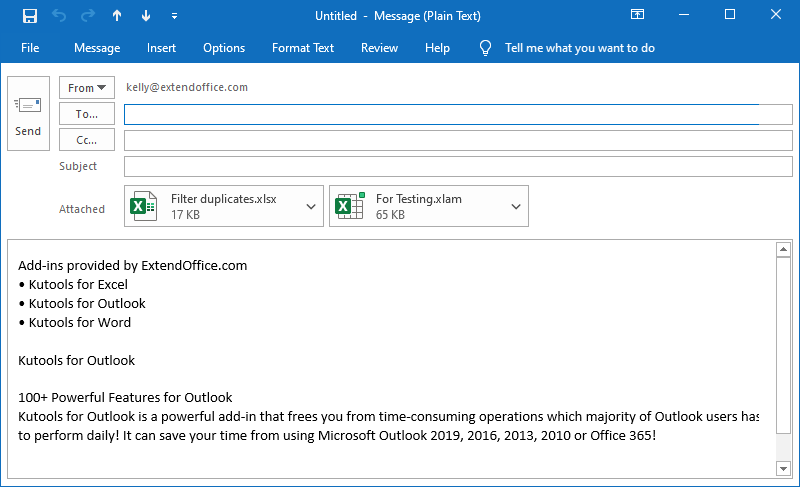
1.3 Rich Text
The Rich Text Format also supports multiple font formatting, hyperlinks, tables, shapes, pictures, etc. However, most of formatting in the Rich Text message are only compatible with Microsoft Outlook and Microsoft Exchange. What is more, the attachments are embedded in the message body instead of attached in the message header.

2. Change message format to HTML, Rich Text Format, or plain text
When composing new messages, or replying/forwarding messages in Outlook, we can easily change the message format.
In the new composing, replying, or forwarding message window, just click the HTML, Plain Text, or Rich Text button in the Format group on the Format Text tab.

Note: If the replying or forwarding message is embedded in the reading pane, you need to click the Pop Out button at the top-left corner of reading pane to show the replying or forwarding message in the message window.

3. Change default message format for all new messages
In general, new emails are sent in the HTML format automatically in Outlook. However, in some cases, we need to send new emails in another message format automatically, such as plain text or rich text. Here, this section will guide you to change the default message format for all new outgoing messages in Outlook.
1. Click File > Options.
2. In the Outlook Options dialog, click Mail in the left bar, go to the Compose messages section, and select a new message format from the Compose messages in this format drop-down list.
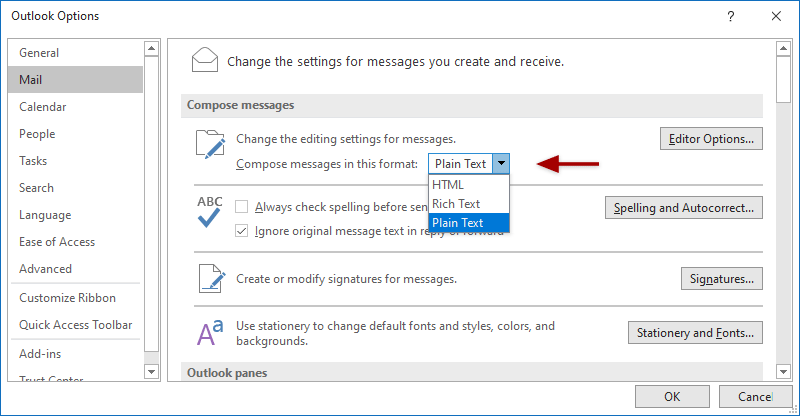
3. Click the OK button to save the changes and close the dialog.
From now on, all new messages will be changed to the specified message format automatically.
4. Change message format of a received email
In general, we received multiple emails every day in Outlook, and these emails may be in HTML format, Plain Text format, or Rich Text format. Here, this section will show you the tutorial to quickly changing the format of a received email in Outlook.
1. In the message list, double click to open the specified email.
2. Then the email is opening in a message window. Click Message > Actions > Edit Message.

3. Now the message is editable. Go ahead to enable the Format Text tab, and then click the specified message format you will convert the email to in the Format group.

4. Press Ctrl + S keys or click the Save button (by default the Save button is in the quick access toolbar above the tabs) to save the changes, and then close the message window.
Note: This method can only change the message format for one received email at a time.
5. Always reply or forward in plain text
If you need to always reply or forward an email in the Plain Text format, this section will solve your issues easily in Outlook.
1. In the main interface of Outlook, click File > Options to open the Outlook Options dialog.
2. In the Outlook Options dialog, click Trust Center in the left bar, and then click the Trust Center Settings button.

3. In the Trust Center dialog, click Email Security in the left bar, and then tick the Read all standard mail in plain text option in the Read as Plain Text section.

4. Click OK buttons successively to close both dialogs.
Now it returns to the main interface of Outlook, and you will see all received emails in the message list are converted to the plain text automatically.
5. Select an email you will reply, and then click Home > Reply or Reply All.
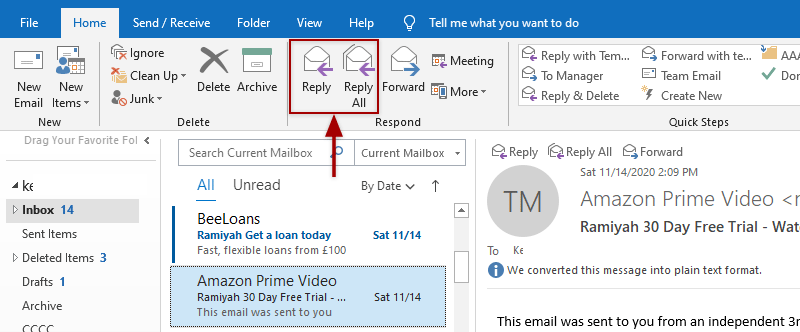
Tips: To forward an email, select the email in the message list, and then click Kutools > Forward.
6. Then you will see the replying message or the forwarding message is created in the Plain Text format. You can compose the replying message, and send it as you need.
Notes: If the Read all standard main in plain text option is enabled, all received emails will be converted to the Plain Text format automatically.
6. Always reply or forward in HTML format
If you need to reply or forward emails in the HTML format in Outlook, you can try below VBA code to solve the problem easily.
1. In Outlook, press Alt + F11 keys to open the Microsoft Visual Basic for Applications window.
2. In the Microsoft Visual Basic for Applications window, click Insert > Module, and then paste below code into the new module.
VBA: Reply or forward emails in the HTML format Automatically
Sub ForceReplyInHTML() 'update by ExtendOffice.com on 11/18/2020 Dim xSelection As Outlook.Selection Dim xItem As Object Dim xMailItem As Outlook.MailItem Dim xRMail As Outlook.MailItem Dim xIsPlainText As Boolean Dim xWinStr As String On Error Resume Next xWinStr = TypeName(Application.ActiveWindow) If xWinStr = "Explorer" Then Set xSelection = Application.ActiveExplorer.Selection If xSelection.Count > 0 Then Set xItem = xSelection.Item(1) Else MsgBox "No message item selected. " & "Please make a selection first.", vbInformation, "Kutools for Outlook" Exit Sub End If ElseIf xWinStr = "Inspector" Then Set xItem = Application.ActiveInspector.CurrentItem Else MsgBox "Unsupported Window type. " & vbNewLine & "Please make a selection" & "or open an item first.", vbInformation, "Kutools for Outlook" Exit Sub End If If xItem.Class <> olMail Then MsgBox "No message item selected. " & "Please make a selection first.", vbInformation, "Kutools for Outlook" Exit Sub End If xIsPlainText = False Set xMailItem = xItem If xMailItem.BodyFormat = olFormatPlain Then xIsPlainText = True End If xMailItem.BodyFormat = olFormatHTML Set xRMail = xMailItem.Reply 'If need to Reply to all recipients in HTML, change xMailItem.Reply to xMailItem.ReplyAll 'If need to forward in HTML, change xMailItem.Reply to xMailItem.Forward If xIsPlainText = True Then xMailItem.BodyFormat = olFormatPlain End If xRMail.Display (False) Set xItem = Nothing Set xMailItem = Nothing Set xRMail = Nothing End Sub
Notes: Above code will help you to reply emails in the HTML Format. If you want to reply all or forward emails in the HTML format automatically, you can do as follows:
(1) To reply to all recipients in the HTML format, replace the left code with the right one:
Set xRMail = xMailItem.Reply  Set xRMail = xMailItem.ReplyAll
Set xRMail = xMailItem.ReplyAll
(2) To forward emails in the HTML format, replace the left code with the right one:
Set xRMail = xMailItem.Reply  Set xRMail = xMailItem.Forward
Set xRMail = xMailItem.Forward
3. Now you can click to select an email, and in the specified module window click the Run button or press F5 keys to reply, reply all, or forward the email in HTML format.
However, it will be boring to open the specified module window to run the VBA code manually from time to time. If we need to apply this VBA frequently, to ease our work, we can add this VBA to the quick access toolbar as a command button, so that we can apply this VBA module by only one click easily in future.
4. In the specified module window, press Ctrl + S keys to save the code, and then close the module window and the Microsoft Visual Basic for Applications window.
5. In the main interface of Outlook, click the small arrow ![]() in the quick access toolbar, and then select More Commands from the drop-down menu.
in the quick access toolbar, and then select More Commands from the drop-down menu.
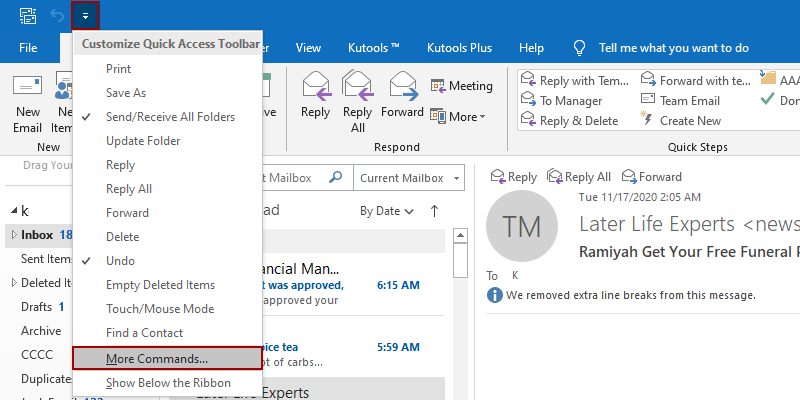
Notes: You can also click File > Options to open the Outlook Options dialog, and then click the Quick Access Toolbar in the left bar.
6. Now the Outlook Options dialog comes out, and the Quick Access Toolbar is enabled in the left bar. You can go ahead as follows:
(1) Select Macros from the Choose commands from drop-down list;
(2) In the left list box, click to highlight the specified VBA command we added just now;
(3) Click the Add button.

7. Now the specified VBA command is added to the right list box. Go ahead to do as follows:
(1) In the right list box, click to highlight the specified VBA command;
(2) Click the Modify button;
(3) In the prompting Modify Button dialog, specify a symbol for the VBA command in the Symbol box;
(4) Type an easy understanding name for the VBA command in the Display name box;
(5) Click the OK buttons successively to save the changes and close both dialogs.
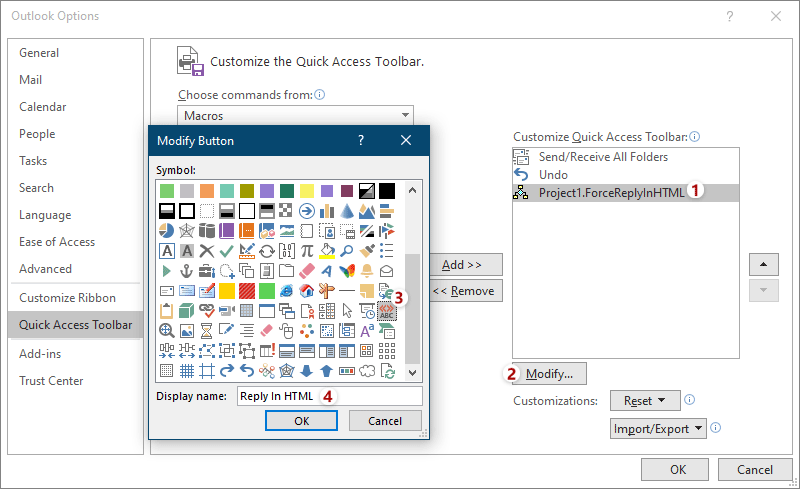
Now the VBA command is added to the quick access toolbar as below screenshot shown.

In future, you can click the VBA command in the quick access toolbar to reply, reply all, or forward the currently selected email in the HTML format, no matter which message format the original email is in.
7. Always reply or forward in HTML, Plain Text, or Rich Text format In Outlook
If you want to reply or forward emails in the plain text format but do not affect the message format of any received emails in Outlook, how could you deal with it? Except above VBA, is there other easy solution to reply or forward in HTML? And what about replying or forwarding in the rich text format automatically? Here, this section will introduce amazing third-party tools, Fixed Reply Formatting and Fixed Forward Formatting provided by Kutools for Outlook to always reply or forward any email with the specified message format automatically.
Kutools for Outlook: Supercharge Outlook with over 100 must-have tools. Test drive it for FREE for 30 days, no strings attached! Read More... Download Now!
1. Click Kutools > Fixed Formatting > Fixed Reply Formatting > Set Reply Formatting.

Note: To forward anyone email in a fixed message format, please click Kutools > Fixed Formatting > Fixed Froward Formatting > Set Forward Formatting.
2. In the Set Reply Formatting or Set Forward Formatting dialog, check the specified message format you will always reply or forward in, and click the OK button.
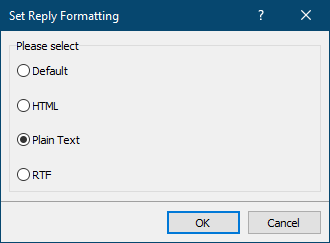
3. Go ahead to click Kutools > Fixed Formatting > Fixed Reply Formatting (or Fixed Forward Formatting) > Enable Fixed Reply Formatting (or Enable Fixed Forward Formatting) to enable the feature.

And in the popping out reconfirming Kutools for Outlook dialog, click the OK button.
From now on, when you click Home > Reply, Reply All, or Forward to reply/forward an email, the replies or forwards will be changed to the specified message format automatically.

More articles ...
Best Office Productivity Tools
Experience the all-new Kutools for Outlook with 100+ incredible features! Click to download now!
📧 Email Automation: Auto Reply (Available for POP and IMAP) / Schedule Send Emails / Auto CC/BCC by Rules When Sending Email / Auto Forward (Advanced Rules) / Auto Add Greeting / Automatically Split Multi-Recipient Emails into Individual Messages ...
📨 Email Management: Recall Emails / Block Scam Emails by Subjects and Others / Delete Duplicate Emails / Advanced Search / Consolidate Folders ...
📁 Attachments Pro: Batch Save / Batch Detach / Batch Compress / Auto Save / Auto Detach / Auto Compress ...
🌟 Interface Magic: 😊More Pretty and Cool Emojis / Remind you when important emails come / Minimize Outlook Instead of Closing ...
👍 One-click Wonders: Reply All with Attachments / Anti-Phishing Emails / 🕘Show Sender's Time Zone ...
👩🏼🤝👩🏻 Contacts & Calendar: Batch Add Contacts From Selected Emails / Split a Contact Group to Individual Groups / Remove Birthday Reminders ...
Use Kutools in your preferred language – supports English, Spanish, German, French, Chinese, and 40+ others!


🚀 One-Click Download — Get All Office Add-ins
Strongly Recommended: Kutools for Office (5-in-1)
One click to download five installers at once — Kutools for Excel, Outlook, Word, PowerPoint and Office Tab Pro. Click to download now!
- ✅ One-click convenience: Download all five setup packages in a single action.
- 🚀 Ready for any Office task: Install the add-ins you need, when you need them.
- 🧰 Included: Kutools for Excel / Kutools for Outlook / Kutools for Word / Office Tab Pro / Kutools for PowerPoint